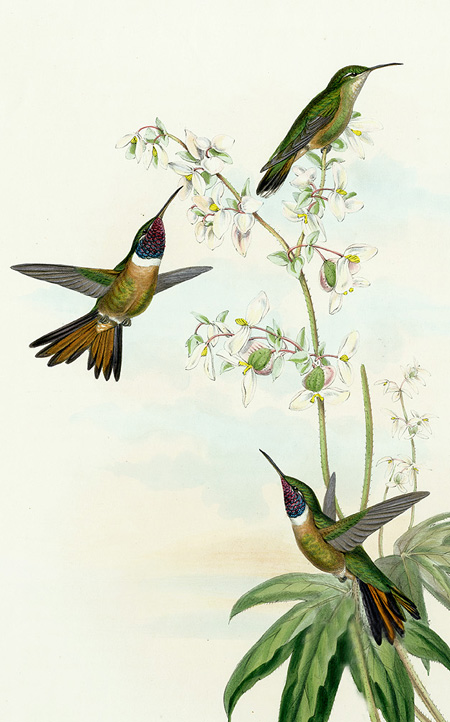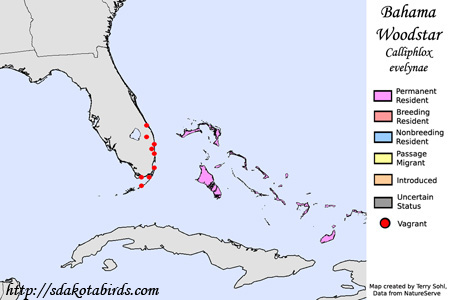| Length: 3.5 inches | Wingspan: 4.25 inches | Seasonality: Non-resident in South Dakota |
| ID Keys: Males with reddish gorget with white collar (breeding season), green above, buffy and olive below, deeply forked tail (male) with black outer feathers | ||
 The
Bahama Woodstar is, appropriately, the most common hummingbird found on the
islands of the Bahamas. They are one of only three endemic birds to
the Bahamas. In the U.S., they will sometimes stray to southern
Florida, and are most often seen when visiting hummingbird feeders. A
unique sub-species with purple feathers on the forehead is found on the
island of Inagua, but the subspecies typically doesn't range to the U.S.
Bahama Woodstars will breed at any season in their native range, with
indications that nesting most often occurs after periods of heavy rain,
which results in a flush of flowering plants. However, early- to
mid-spring is the most common time for nesting.
The
Bahama Woodstar is, appropriately, the most common hummingbird found on the
islands of the Bahamas. They are one of only three endemic birds to
the Bahamas. In the U.S., they will sometimes stray to southern
Florida, and are most often seen when visiting hummingbird feeders. A
unique sub-species with purple feathers on the forehead is found on the
island of Inagua, but the subspecies typically doesn't range to the U.S.
Bahama Woodstars will breed at any season in their native range, with
indications that nesting most often occurs after periods of heavy rain,
which results in a flush of flowering plants. However, early- to
mid-spring is the most common time for nesting.
Habitat: Will use a variety of semi-open and brushy habitats, including forest edges and brushy undergrowth, areas of low-growing, scrubby vegetation, and suburban gardens.
Diet: Typical diet of Hummingbirds, feeding heavily on nectar. Insects can comprise a large portion of the diet.
Behavior: Aggressive, will fiercely defend prime feeding territory from other hummingbirds and other birds as well. However, they typically show very little fear of human beings, often allowing a very close approach as they perch.
Nesting: Nests are small cups made of downy plant fibers, bits of bark, and spider webs, and will expand as the young grow. Two eggs are typically laid. Nest sites are typically in vegetation from 2 to 12 feet above the ground. Females alone incubate and raise the young.
Interactive eBird Map: Click to access an interactive eBird map of Bahama Woodstar sightings
Song: Song of the Bahama Woodstar is a series of tic notes...tic..tic-tic...tic...tic...tic-tic.
Migration: Most birds are non-migratory. Strays found in southern Florida have appeared at nearly any time of the year.
Feeders: Will attend hummingbird feeders
Similar Species: Berylline Hummingbird
Conservation Status: Still common and widespread throughout their normal range in the Bahamas. There are some indications that the species is a more common visitor than once thought in South Florida .
Further Information: 1) WhatBird - Bahama Woodstar
2) Beauty of Birds - Bahama Woodstar
Photo Information: Hand-colored lithograph plate of Bahama Woodstar by John Gould, 1861. Gould produced 418 individual hand-colored plates for his monograph on hummingbirds, published in 1861.
Additional Photos: Additional Photos Coming Soon!!
| Click below for a higher-resolution map |
 |
| South Dakota Status: Non-resident in South Dakota |
Additional Bahama Woodstar Photos (coming soon -- if someone sends me tickets to the Bahamas...)
